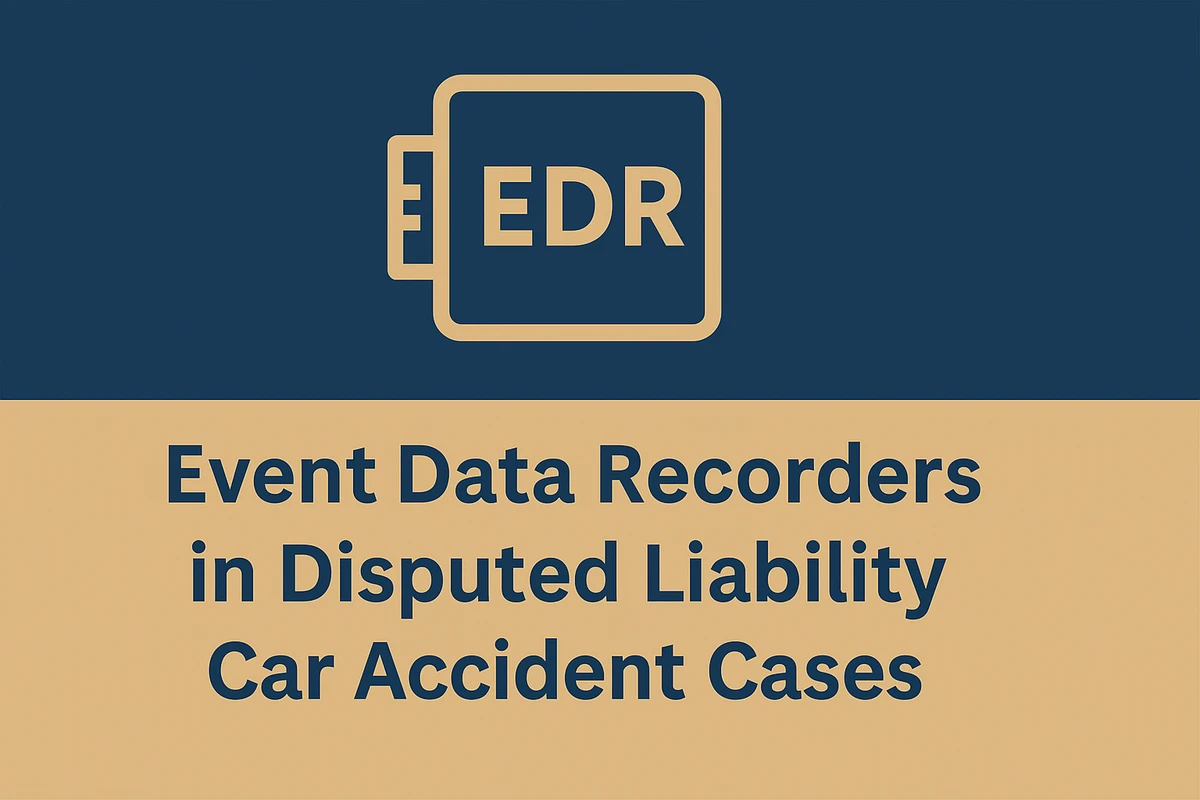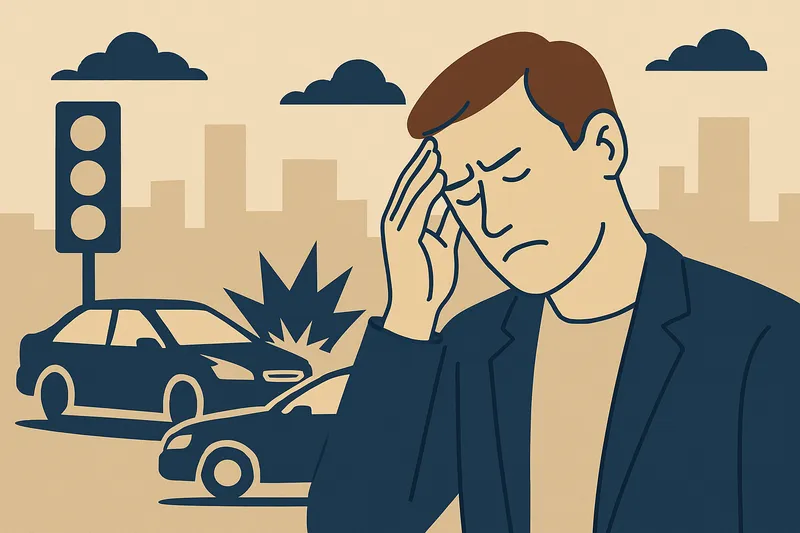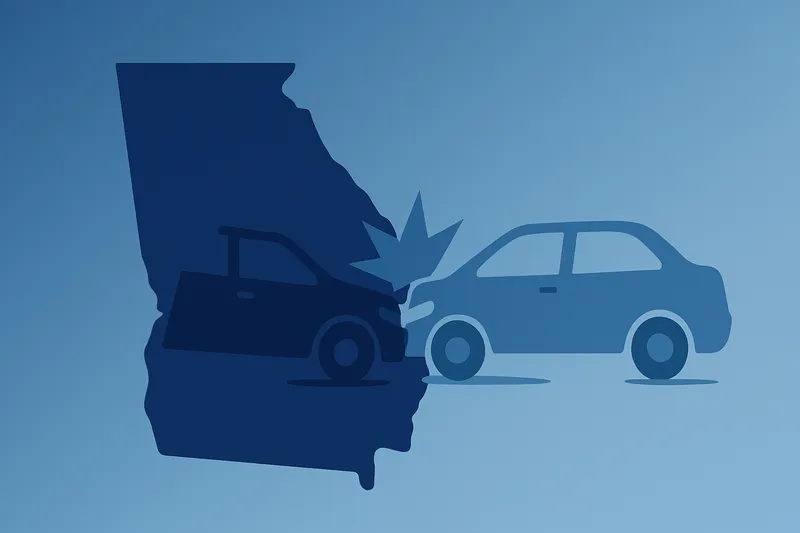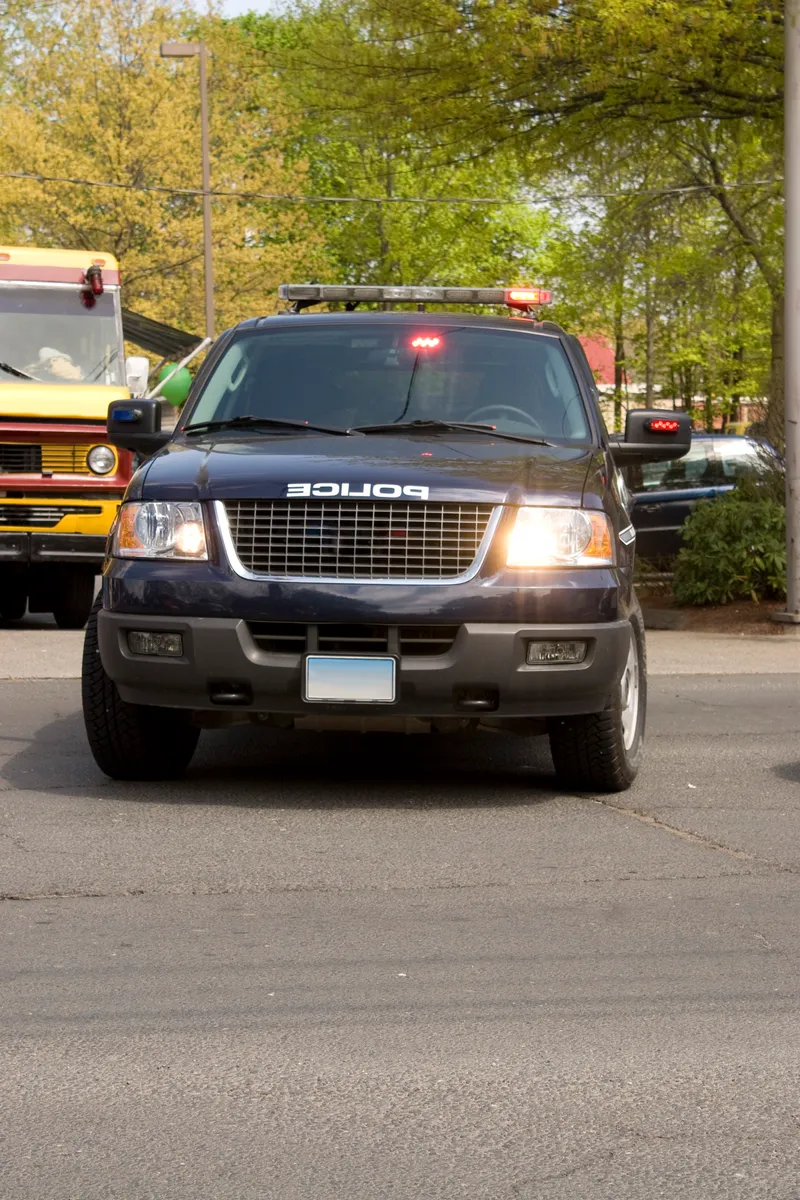Event Data Recorders in Georgia Car Accidents: How “Black Box” Data Can Resolve Disputed Liability

Published: 3/29/2025
When a car accident happens and both drivers or insurers blame each other, it can be stressful for the injured victim. In Georgia, disputed liability cases are common, but modern technology can help uncover the truth. One important tool is the vehicle’s Event Data Recorder (EDR) – often called a car “black box.” This device captures key data in the moments around a crash and can be pivotal in proving who was really at fault. Below, we explain what EDRs are, what data they collect, how that data is accessed and used under Georgia law, and how a Georgia car accident lawyer can leverage EDR evidence to support your personal injury claim. We also provide practical guidance for accident victims facing blame or uncertainty about proving their case.
Event Data Recorders are devices installed in most modern cars and trucks that record technical information about the vehicle right before, during, and after a collision
Nearly all new cars on the road today come equipped with some form of EDR. This means that if you were in a Georgia car accident, there is a high likelihood that your vehicle, the other vehicle, or both have recorded data from the incident. The EDR does not record everything like a dash cam would – it doesn’t capture audio, video, or continuous GPS location history. Instead, it preserves vehicle performance data from the critical moments surrounding a crash. In other words, it won’t tell where you drove every day, but it will tell what the car was doing in the seconds leading up to and during the collision.
What Data Do Car “Black Boxes” Record?
An EDR’s data can provide an objective snapshot of how a vehicle was being driven just before and during impact. The exact data recorded can vary by manufacturer, but most EDRs collect similar types of information. Common EDR data from car crashes includes:
Vehicle Speed and Changes in Speed: How fast the car was traveling, and whether it was accelerating or decelerating before impact (This can show if a driver was speeding or if they braked hard to avoid a crash.)
Brake Usage: When and how the brakes were applied. The recorder may log if the brake pedal was pressed, and for how long, in the moments leading up to the crash
Throttle (Accelerator) Position: Whether the driver was pressing the gas pedal, indicating acceleration, and the degree of throttle input prior to the crash.
Steering Input: Some EDRs note steering wheel angle or sudden steering maneuvers, which can indicate swerving or corrective actions.
Seat Belt Status: Whether the driver and front passenger had seat belts fastened.
Airbag Deployment Info: Whether airbags deployed, which ones, and the timing of deployment
Impact Forces (Delta-V): The change in velocity upon impact (Delta-V), which indicates crash severity.
Number of Collision Events: If there were multiple impacts (e.g. a secondary collision), the EDR might record the number of events and the time between them – useful in multi-car pileups to sequence the crashes.
Engine RPM and Other Data: Some devices log engine speed, or whether the engine was at idle or full throttle, etc., and other technical data related to the crash.
This EDR data provides a factual, timestamped record of what the vehicle was doing just before and at the moment of collision. For example, if one driver claims they were only going 40 MPH at impact, the black box might show they were actually driving 60 MPH and never hit the brakes – crucial evidence for determining fault. Because it’s collected by the car’s computer, this data isn’t subject to human memory lapses or bias; it’s objective evidence.
How EDR Data Can Prove Fault in Disputed Liability Cases
In a disputed liability accident case, each side may have a conflicting story of what happened. This is where EDR data can be a game-changer. Black box data can help confirm or refute driver accounts of the crash, providing clarity when eyewitnesses or the drivers disagree. Here are a few ways EDR data can be used to prove fault:
Corroborating Your Story: If you insist you were driving safely and the other driver caused the wreck, the EDR can back you up. For instance, data might show you were within the speed limit and braked when hazard arose, while the other driver’s vehicle data (if available) might show they were speeding or didn’t brake at all. Such evidence can corroborate your version of events and strengthen your credibility.
Identifying Traffic Law Violations: EDR data often directly points to traffic violations – e.g. excessive speed, failure to brake, or aggressive steering. If the data shows the other driver was going 20 MPH over the limit or made a sharp maneuver that led to the crash, it clearly indicates fault on their part.
Refuting False Claims: Insurance companies and at-fault drivers may sometimes blame the victim or claim you did something wrong. Black box data can directly refute false claims. For example, if the other driver says “you stopped suddenly” to pin blame on you, your car’s EDR might show you were braking gradually and reasonably. Or if they claim they “had no time to react,” their own EDR could show a several-second delay in braking. This objective data eliminates guesswork and undercuts baseless accusations.
Resolving “He Said/She Said” Situations: In many crashes with no independent witnesses, it becomes a word-versus-word scenario. EDR evidence can tip the scales by providing a factual narrative. It’s hard for a driver to argue against the electronic record showing their actions. For example, black box data can definitively show which car was moving and which was stationary at impact, or how long each driver had to react – details that might otherwise be contested.
In short, EDRs help paint a scientifically accurate picture of the moments before a crash, which can be the key to proving fault in a disputed liability case. Georgia accident attorneys often consider EDR evidence to be one of the most compelling pieces of proof because it’s unbiased. It can either support witness testimony or expose lies, ensuring that liability is assigned based on facts rather than false narratives.
Accessing “Black Box” Data After a Car Accident in Georgia
Despite how valuable EDR data is, accessing it is not as simple as plugging in a USB stick. The data is stored in your vehicle’s crash memory module and requires specialized tools to retrieve. Additionally, there are legal and privacy considerations, especially in Georgia, regarding who can download that data.
To get EDR data, a technician or accident reconstruction expert must connect a Crash Data Retrieval (CDR) tool or a manufacturer-specific interface to the vehicle’s computer (often via the OBD-II diagnostic port). Using specialized software, they download (or “image”) the data without altering it. This process typically needs to be done by professionals with the proper equipment (e.g. Bosch CDR kits are commonly used for many car makes). For newer vehicles, especially ones heavily damaged, sometimes the EDR module may need to be removed and read directly. Because of this complexity, your attorney will usually work with accident reconstruction experts to handle the data extraction.
Legal Ownership of Data: Under both federal and state law, EDR data is generally considered the property of the vehicle’s owner. Georgia follows this principle – the information in a car’s black box belongs to the owner of that car (or the lessee). This means you own the data on your car’s EDR, and an insurance company or police officer typically cannot access it without permission or a court order. Likewise, if you need data from the other driver’s vehicle, you cannot simply take it; you’ll need legal steps to obtain it.
Georgia Law on EDR Access:
Georgia has recognized the privacy of vehicle data. In fact, in 2019 the Georgia Supreme Court ruled that police must obtain a warrant to download a car’s EDR data during an investigation. This case (Mobley v. State) affirmed that the Fourth Amendment’s privacy protections apply to the digital data our cars collect. For civil cases, the principle is similar: to access another vehicle’s EDR, one must go through proper legal channels, such as a subpoena or discovery request. In other words, if you file a lawsuit over the accident, EDR data from all vehicles can be obtained through the legal discovery process. Your attorney can petition the court to have the EDR data preserved and downloaded for use as evidence.
Preserving the Data
Time is critical when dealing with black box information. Some EDRs will only save data for a limited time or a limited number of ignition cycles (engine on/off). For example, many cars store crash data until roughly 200 ignition cycles have passed (which might be only six to eight weeks of normal driving). After that, the data may be overwritten. Additionally, if the vehicle is repaired or totaled, the EDR device could be lost or reset. Because of this, Georgia car accident lawyers urge quick action to secure EDR data. After a serious accident, a swift response is often necessary to preserve all relevant data from the vehicles. An experienced attorney will send formal letters to the opposing party (and their insurer) instructing them to preserve the vehicle and EDR data (this is sometimes called a spoliation letter). This puts everyone on notice not to destroy or tamper with the black box information. If a party were to intentionally destroy EDR data after being put on notice, Georgia courts could impose sanctions for spoliation of evidence.
In practice, if you hire a lawyer soon after the crash, they can coordinate the downloading of EDR data from your car and even the other driver’s car (with the proper legal approval). Often, both sides will agree to preserve and share this data because it is in neither side’s interest to have it lost – it could hurt their case if they are seen as allowing evidence to be destroyed. The bottom line is that accessing black box data requires a combination of technical expertise and legal procedure. A Georgia accident attorney will know how to navigate this, ensuring that crucial EDR evidence is obtained lawfully and safely for your cases.
Georgia Laws and Court Rulings on EDR Evidence
When EDR evidence is obtained properly, Georgia courts generally consider it admissible evidence in accident cases. There is nothing “mystical” about black box data in the eyes of the law – it’s treated like any other expert evidence. However, to be used in court, it must be shown that the data is relevant, reliable, and was retrieved in compliance with legal requirements. Typically this means an expert (like an accident reconstructionist) will testify about how the data was downloaded and that it hasn’t been altered. If those foundations are laid, the data showing speed, braking, etc., can be presented to the jury or insurance adjusters to support the facts of the case.
It’s also worth noting that Georgia’s evidence rules, like other states’, require that scientific or technical evidence come from qualified experts. So EDR data is usually introduced alongside an expert’s accident analysis. For example, an expert might explain how the data indicates Driver A was going 65 MPH in a 45 zone at 2 seconds before impact, and had 0% brake pedal application, indicating no braking. This kind of testimony, supported by the EDR readout, can be very powerful.
In summary, Georgia law supports the use of EDR data in both insurance claims and court, as long as it’s obtained lawfully and presented properly.. The state has embraced this technology as a way to get to the truth of accidents, while also setting safeguards (like the warrant requirement for police) to protect individuals’ privacy rights. A knowledgeable Georgia car accident lawyer will stay up-to-date on any changes in laws or precedents regarding EDRs, ensuring that your case makes full, proper use of this evidence.
The Impact of EDR Evidence on Personal Injury Claims and Insurance Disputes
Having solid EDR evidence can significantly influence the outcome of a personal injury claim arising from a car accident – especially when liability is disputed.
Insurance companies are accustomed to debates over who caused a crash. When you can present hard data (e.g. a report from an EDR showing the other driver was driving recklessly), it lends tremendous weight to your claim. Objective data that clearly places fault on the other party can lead to quicker settlements and better compensation offers, because the insurer knows a jury would likely find their driver at fault. Essentially, clear EDR evidence can push the insurance company to stop denying liability and start discussing damages.
Disputed liability cases often drag on as each side investigates and argues. EDR data can cut through delays by quickly providing clarity. For instance, if both drivers blamed each other for running a red light, the EDR might show one car’s speed and braking pattern inconsistent with stopping for a red light. With that evidence, the at-fault driver’s insurer might concede sooner. This means you, as the injured victim, could resolve your claim faster and move on, rather than enduring a prolonged fight.
Sometimes an insurance adjuster may try to pin some blame on you to reduce what they have to pay (this is called comparative negligence). Black box data can shut down those tactics. If the data proves you did nothing wrong (for example, you were driving at a safe speed and braked appropriately), it’s hard for the insurer to argue you were partially at fault. This helps ensure you are not unfairly blamed and that you can pursue your full compensation.
If your case goes to trial, jurors tend to find electronic data persuasive. It’s concrete and scientific. Seeing a printout or hearing an expert explain that “Car A was going 70 mph and didn’t brake at all before impact” is often more impactful than hearing a driver simply say “I think he was speeding.” So, EDR evidence can paint a compelling narrative at trial, potentially leading to a favorable verdict on liability.
Overall, EDR evidence can significantly tilt a personal injury claim in the victim’s favor by providing clarity and proof.
It helps counter common insurance company strategies that might undervalue or deny valid claims. With EDR data, you and your attorney can make a more convincing case for the full damages you are owed – from medical bills and lost wages to pain and suffering – because the fault of the other party is backed by hard evidence. How a Georgia Car Accident Lawyer Uses EDR Data to Support Your Case
If you’ve been injured and suspect the crash data could prove the other driver was at fault, it’s crucial to involve a knowledgeable Georgia car accident lawyer.
A seasoned lawyer will immediately consider whether an EDR download is necessary. They will identify which vehicles involved have EDRs (remember, nearly every newer car does). Early on, they will send out preservation letters to prevent any loss of that data. For example, if the other driver’s car is in a towing yard, your attorney will notify them and the insurer not to destroy or alter the vehicle or its electronic data. This quick action ensures that even if your case is just in the claim stage, the EDR evidence will still be there if needed.
Raw EDR data comes as a report with numbers – your attorney will work with experts who can interpret it in plain English. The expert can analyze the readings (speed charts, brake switch on/off, etc.) and reconstruct the crash. Your lawyer will then use this analysis to formulate a clear picture of how the accident happened. For instance, an expert report might conclude: “The data indicates Vehicle A was traveling at 55 MPH and began braking 1.5 seconds before impact, reducing speed to 35 MPH at collision. Vehicle B was traveling at 45 MPH and showed no brake application prior to impact.” This kind of analysis can be extremely persuasive when negotiating with insurance adjusters or presenting in court.
Negotiating with EDR Evidence
When making an insurance claim, your lawyer will present the EDR findings to the insurance company along with other evidence (photos, skid marks, witness statements, etc.). Having concrete black box data strengthens your claim package. Your attorney can argue, for example, “We have electronic evidence your insured was going 20 mph over the limit and never braked – a clear indication of negligence.” This often pressures the insurer to settle fairly rather than risk going to trial with such evidence against their driver.
- Litigation and Trial Strategy: If the case proceeds to a lawsuit, an attorney will formally introduce the EDR data through discovery and eventually in court if needed. They will ensure the evidence meets admissibility standards (through the expert’s testimony). In a trial, your lawyer can use the black box data to tell a compelling story of the crash. Visual aids might be used – such as charts of speed over time – to show the jury exactly how the events unfolded. The lawyer will highlight the EDR evidence that supports your innocence or the other party’s fault, making it a centerpiece of the case to persuade the jury.
If you or a loved one were injured in a crash and find yourself facing blame or uncertainty, take heart: the facts, often recorded in your vehicle’s EDR, can be your ally.
By promptly consulting a lawyer and leveraging all available evidence, you can turn a “disputed liability” case into a clear demonstration of what really happened. Black box data doesn’t lie – and when used effectively, it can ensure that the responsible party is held accountable and that you receive the compensation you deserve. In the end, technology like EDRs, combined with skilled legal advocacy, offers accident victims in Georgia a reassuring path to prove their case and move forward with confidence.
Related Articles



